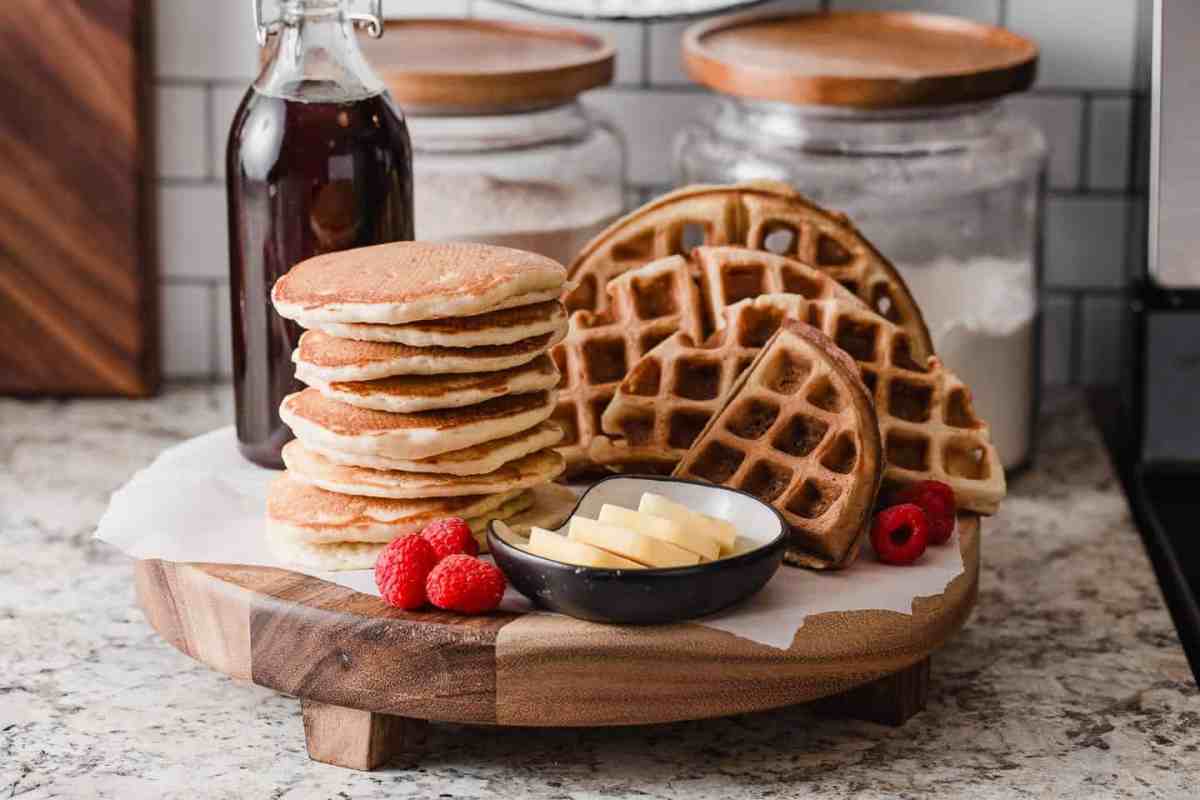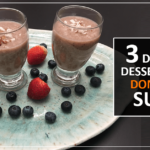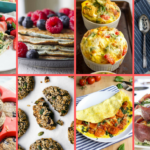Imagine waking up to the irresistible aroma of fluffy pancakes or crispy waffles, guilt-free and bursting with flavor. This isn’t a dream; it’s the reality offered by low-glycemic alternatives. This guide dives deep into creating delicious, healthy pancakes and waffles using alternative flours like almond, coconut, and oat, and sweeteners such as stevia and erythritol. We’ll explore the nuances of each ingredient, providing you with the knowledge and recipes to craft the perfect low-glycemic breakfast, every morning.
From mastering the art of achieving that perfect golden-brown crust on your pancakes to the satisfying crispiness of your waffles, we’ll cover everything you need to know. We’ll also explore creative topping combinations, both sweet and savory, to keep your breakfast exciting and satisfying. Prepare to elevate your morning routine with recipes that are as good for your body as they are for your taste buds.
Ingredient Exploration
Crafting low-glycemic pancakes and waffles requires careful consideration of flour and sweetener choices. The right combination will deliver fluffy texture, delightful flavor, and the desired blood sugar control. Let’s delve into the specifics of choosing the optimal ingredients for your healthy breakfast.
Low-Glycemic Flour Options
Almond flour, coconut flour, and oat flour each offer unique characteristics impacting the final product. Understanding their strengths and weaknesses is key to successful low-glycemic baking.
- Almond Flour: Provides a slightly nutty flavor and a tender crumb. It’s relatively high in fat, contributing to a moist texture. However, it can be quite absorbent, potentially requiring adjustments to liquid ratios in your recipe. Using too much can lead to dense pancakes or waffles.
- Coconut Flour: Offers a distinct coconut flavor and a naturally dense texture. It’s highly absorbent, demanding more liquid than other flours. This flour can create a slightly drier final product if not managed correctly, but it does offer a good source of fiber.
- Oat Flour: Made from ground oats, oat flour provides a mild, slightly sweet flavor and a relatively light texture. It’s a good source of fiber and can create pancakes and waffles with a slightly chewier consistency compared to almond or coconut flour. However, ensure you use certified gluten-free oat flour if avoiding gluten is a concern.
Alternative Sweetener Impact
The choice of sweetener significantly influences both the taste and texture of your low-glycemic pancakes and waffles. Each option presents a unique flavor profile and potential impact on the final product’s consistency.
- Stevia: Known for its intense sweetness, stevia requires careful measurement. Too much can lead to a slightly bitter aftertaste. It generally doesn’t impact texture significantly, allowing for fluffy results.
- Erythritol: Offers a clean, slightly cooling sensation and blends well with other flavors. It doesn’t significantly affect the texture, providing a similar outcome to using sugar. However, excessive consumption may lead to digestive discomfort in some individuals.
- Monk Fruit: Possesses a subtly sweet flavor with a hint of melon. It is very sweet, so only a small amount is needed. It generally doesn’t alter texture noticeably, maintaining the desired fluffiness.
Substituting Common Baking Ingredients
Replacing traditional high-glycemic ingredients with low-glycemic alternatives requires careful consideration of ratios and properties. Here’s a guide to successful substitutions:
- All-Purpose Flour: Replace 1 cup of all-purpose flour with a blend of 1/2 cup almond flour and 1/2 cup oat flour, or experiment with different combinations depending on your desired texture. Coconut flour requires a different approach, often needing less due to its absorbency; start with 1/4 cup and adjust as needed.
- Sugar: Substitute granulated sugar with your preferred low-glycemic sweetener, starting with approximately 1/4 to 1/2 the amount of sugar called for in the original recipe, then adjust to taste. Remember that alternative sweeteners vary in sweetness levels.
- Baking Powder/Baking Soda: These leavening agents generally remain the same, but slight adjustments might be needed depending on the flour blend you choose. Experiment to find the perfect ratio for a light and fluffy outcome. Too much leavening can lead to a dry or crumbly texture.
Cooking Methods & Techniques

Mastering the art of low-glycemic pancakes and waffles hinges on understanding the nuances of cooking methods and achieving the perfect balance of texture and flavor. The right technique ensures a crispy exterior, a fluffy interior, and a delightful overall eating experience. Proper batter consistency plays a crucial role, impacting both the cooking process and the final product’s appearance and taste.
Griddle-Cooked Low-Glycemic Pancakes
Achieving perfectly browned, fluffy low-glycemic pancakes on a griddle requires attention to detail and a steady hand. The key is to maintain consistent heat and avoid overcrowding the cooking surface. Overcrowding leads to steaming instead of browning, resulting in soggy pancakes.
- Prepare the Griddle: Heat a lightly oiled griddle or non-stick pan over medium heat. The ideal temperature is reached when a drop of water sizzles immediately upon contact.
- Portion the Batter: Using a 1/4 cup measuring cup, pour small dollops of batter onto the hot griddle, leaving space between each pancake to allow for even cooking and browning. Avoid spreading the batter; let it spread naturally.
- Monitor Browning: Cook for 2-3 minutes per side, or until golden brown and cooked through. Flip only when bubbles begin to form on the surface and the edges appear set. A spatula gently slid under the pancake should meet little resistance.
- Adjust Heat as Needed: If the pancakes are browning too quickly, reduce the heat slightly. If they are cooking too slowly, increase the heat gently. Maintain even browning throughout the cooking process.
- Serve Immediately: Low-glycemic pancakes are best served immediately after cooking. Their texture and flavor are at their peak when warm.
Waffle Iron Low-Glycemic Waffles
Cooking low-glycemic waffles in a waffle iron offers a delightful crispy exterior and a light, fluffy interior. The success lies in the proper batter consistency and the waffle iron’s temperature. Using a waffle iron with adjustable temperature control allows for optimal cooking and texture customization.
- Preheat the Waffle Iron: Preheat the waffle iron according to the manufacturer’s instructions. A properly preheated iron ensures even cooking and prevents sticking.
- Pour the Batter: Pour the batter into the preheated waffle iron, filling the compartments about ¾ full. Avoid overfilling, as this can lead to overflow and uneven cooking.
- Cook to Golden Brown: Cook the waffles according to the waffle iron’s instructions, usually 3-5 minutes. The waffle is ready when it’s golden brown and springs back when lightly touched.
- Proper Batter Consistency: A slightly thicker batter than that used for pancakes will create a crispier waffle. Too thin a batter will result in a soggy waffle. A batter that is too thick may be dense and dry.
- Serve Immediately: Similar to pancakes, low-glycemic waffles are best enjoyed immediately after cooking, while they are warm and crispy.
Batter Consistency: The Key to Success
The consistency of the batter is paramount in achieving the desired texture for both pancakes and waffles. Too thin a batter will result in flat, flimsy pancakes or soggy waffles, while a batter that’s too thick will produce dense, dry pancakes or heavy, chewy waffles. The ideal consistency should be pourable but not runny. For pancakes, the batter should be slightly thinner than that used for waffles to allow for a more tender texture. Visualize the batter as having a smooth, creamy consistency, similar to heavy cream. A slightly thicker batter for waffles will result in a more substantial, crispy texture. The batter should coat the back of a spoon smoothly without dripping off excessively.
Serving Suggestions & Flavor Combinations
Elevating your low-glycemic pancakes and waffles from simply healthy to utterly delicious requires thoughtful consideration of toppings and savory additions. The right combination can transform a breakfast staple into a culinary masterpiece, brimming with flavor and texture. This section explores both sweet and savory options to inspire your morning meal creativity.
Sweet Topping Combinations for Low-Glycemic Pancakes and Waffles
These five combinations showcase the delightful interplay of textures and tastes achievable with healthy, low-glycemic ingredients. Each option provides a balanced nutritional profile and a unique sensory experience.
- Berry Bliss: A vibrant mix of fresh raspberries, blueberries, and sliced strawberries, scattered generously over fluffy pancakes. The juicy bursts of berry sweetness contrast beautifully with the slightly crisp exterior of the pancakes. A sprinkle of chopped pecans adds a satisfying crunch.
- Tropical Temptation: Thinly sliced mango and kiwi, accompanied by a dusting of shredded coconut. The tropical sweetness and vibrant colors create a visually stunning and refreshingly light topping.
- Nutty Delight: A medley of chopped walnuts, almonds, and macadamia nuts, generously sprinkled over warm waffles. The rich, buttery flavors of the nuts complement the subtly sweet waffles, providing a satisfying textural contrast.
- Spiced Apple Cinnamon: Thinly sliced apples sautéed with a touch of cinnamon and a squeeze of lemon juice. This warm, comforting topping offers a delightful balance of sweet and tart flavors, perfectly complementing the warmth of the waffles.
- Seed Sensation: A vibrant mix of chia seeds, pumpkin seeds, and sunflower seeds, lightly toasted and sprinkled over pancakes. The nutty flavor and satisfying crunch add a unique dimension to the pancakes’ texture.
Visual and Textural Descriptions of Sweet Toppings
The visual and textural appeal of a dish significantly impacts the overall dining experience. Here, we highlight three combinations to illustrate this point.
- Berry Bliss: Imagine a plate piled high with golden-brown pancakes, generously adorned with ruby-red raspberries, deep-blue blueberries, and scarlet strawberries. The vibrant colors pop against the warm tones of the pancakes, creating a visually appealing contrast. The textures are equally captivating: the soft, fluffy pancakes yield to the juicy bursts of the berries and the satisfying crunch of the pecans.
- Tropical Temptation: Picture a sunny plate, showcasing golden waffles topped with the bright orange slices of mango, the emerald green of kiwi, and the snowy white of shredded coconut. The colors are reminiscent of a tropical sunrise, evoking feelings of warmth and relaxation. The soft waffles provide a comforting base for the juicy, slightly tart fruits and the delicate crunch of the coconut.
- Nutty Delight: Envision warm, golden waffles generously speckled with the rich browns and creams of chopped walnuts, almonds, and macadamia nuts. The visual appeal is one of rustic abundance, suggesting hearty nourishment. The textures contrast beautifully: the soft waffles provide a gentle contrast to the satisfying crunch of the nuts.
Savory Low-Glycemic Pancake and Waffle Recipes
Savory pancakes and waffles offer a unique and satisfying alternative to their sweeter counterparts. These recipes showcase the versatility of these breakfast staples.
- Spinach and Feta Pancakes: These pancakes incorporate finely chopped spinach into the batter, resulting in a subtly savory and vibrantly green pancake. Crumbled feta cheese is added as a topping, offering a salty, tangy counterpoint to the spinach’s earthiness. The visual appeal is striking: vibrant green pancakes punctuated by the creamy white of the feta.
- Mushroom and Gruyere Waffles: Sautéed mushrooms, with their earthy aroma and tender texture, are incorporated into the waffle batter, creating a savory and flavorful base. A generous sprinkle of grated Gruyere cheese adds a sharp, nutty flavor and a delightful melt-in-your-mouth texture. The waffles offer a visually appealing contrast of earthy browns and creamy yellows.
- Cheddar and Chive Pancakes: These pancakes feature shredded cheddar cheese blended into the batter, giving them a subtly sharp, cheesy flavor. Freshly chopped chives add a bright, herbaceous note. The final product is a golden-yellow pancake, speckled with the green of the chives, offering a delightful visual and textural experience.
Step-by-Step Recipe Creation
This recipe provides a delicious and healthy alternative to traditional pancakes, using almond flour and a touch of sweetener to create a low-glycemic treat. The result is a fluffy pancake with a subtle sweetness and the delightful burst of fresh blueberries. Each step is meticulously detailed to ensure success in your kitchen.
Low-Glycemic Blueberry Pancakes Recipe
This section details the preparation of low-glycemic blueberry pancakes, step by step. The visual descriptions aim to guide you through the process, ensuring you achieve perfectly cooked pancakes.
- Preparing the Dry Ingredients: In a medium-sized bowl, whisk together 1 cup almond flour, 1 teaspoon baking powder, ½ teaspoon baking soda, and a pinch of salt. The mixture will appear light and fluffy, a pale beige color. The almond flour will give a slightly granular texture to the mix.
- Combining the Wet Ingredients: In a separate bowl, whisk together 1 large egg, ½ cup unsweetened almond milk, 1 tablespoon melted coconut oil, and 1 tablespoon of your preferred low-glycemic sweetener (e.g., erythritol or stevia). The mixture should be smooth and slightly creamy, a pale yellowish color from the egg.
- Combining Wet and Dry Ingredients: Gently pour the wet ingredients into the dry ingredients, mixing until just combined. Do not overmix; a few lumps are okay. The batter will be slightly thick and slightly lumpy, a light beige color speckled with tiny white bits from the baking powder and soda. It should have a slightly thicker consistency than regular pancake batter.
- Adding Blueberries: Gently fold in ½ cup fresh blueberries. The blueberries will be scattered throughout the batter, adding pops of vibrant blue-purple color against the pale beige background.
- Cooking the Pancakes: Heat a lightly oiled griddle or frying pan over medium heat. Pour ¼ cup of batter onto the hot surface for each pancake. The batter will spread out slightly, forming a round shape. Cook for 2-3 minutes per side, or until golden brown and cooked through. The cooked pancakes will be a rich golden-brown color, slightly puffed, and have a slightly crispy edge.
- Serving: Serve the pancakes immediately. They are best served warm and can be enjoyed with a dollop of whipped cream (ensure it is low in sugar), a drizzle of maple syrup substitute, or a sprinkle of cinnamon. The finished pancakes present a beautiful contrast between the golden brown of the pancake and the deep purple of the blueberries.
Embarking on a journey to healthier breakfasts doesn’t mean sacrificing taste or enjoyment. With the recipes and techniques Artikeld in this guide, you can confidently create delicious, low-glycemic pancakes and waffles that will become a staple in your morning routine. Experiment with different flours, sweeteners, and toppings to discover your own unique flavor combinations. Enjoy the satisfying crunch, the fluffy texture, and the knowledge that you’re starting your day with a nutritious and delectable treat. The possibilities are endless, so get cooking!
Answers to Common Questions
Can I use regular baking powder in these recipes?
Yes, but be mindful that the rise might be slightly different compared to using a low-glycemic alternative. Experiment to find the best amount for your preferred texture.
How long can I store leftover pancakes and waffles?
Store leftover pancakes and waffles in an airtight container in the refrigerator for up to 3 days. Reheat gently in a pan or toaster.
Are these recipes suitable for people with diabetes?
While these recipes are low-glycemic, it’s crucial to consult with your doctor or a registered dietitian to determine if they are suitable for your specific dietary needs and diabetes management plan. Individual responses to different foods can vary.
Can I freeze these pancakes and waffles?
Yes! Freeze cooked pancakes and waffles in a single layer on a baking sheet before transferring them to a freezer bag for longer storage. Reheat from frozen in a toaster or pan.


